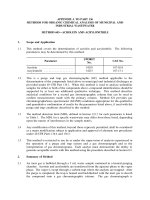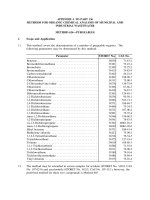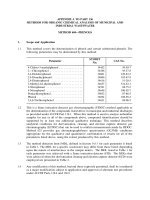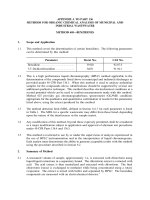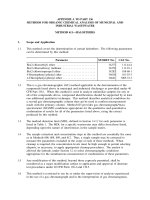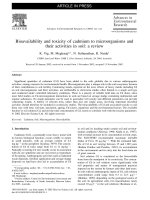The chemical components of detergents and their roles in the washing process
Bạn đang xem bản rút gọn của tài liệu. Xem và tải ngay bản đầy đủ của tài liệu tại đây (15.04 KB, 5 trang )
The chemical components of detergents and their roles in the washing process
Laundry detergents are formulated from six groups of substances :
. surfactants
. builders
. bleaching-agents
. enzymes
. fillers
. other minor additive
Surfactants
Are organic chemicals, obtained through complex chemical reactions, from oil or
fat raw materials. They have wetting, emulsifying and dispersing properties,
enabling the removal of dirt ("soil") from fabrics and keeping the soil
suspended in the washing water.
Detergents usually contain several types of surfactants such as soaps (anionic),
alkylbenzenesulphonate (anionic), ethoxylated fatty alcohols (non-ionic). The
mixture is carefully balanced to control foaming and provide the appropriate
washing efficiency (for the required washing temperatures, types of fabric and
water hardness), at a price the consumer is willing to pay.
However, surfactant efficiency is very much reduced in hard water and their
detergent properties are not complete even in soft water.
Builders
Builders are key detergent components which remove the calcium and magnesium
ions presents in hard water and in soils, thus lowering the concentration of
surfactants necessary to perform the detersive action. Some builders also
prevent the deposition of calcium and magnesium salts on fabrics and washing-
machines.
Sodium tripolyphosphate (STPP) is the most widely used builder and, in
conjunction with surfactants, allows modern detergents to perform efficiently in
all washing conditions, allowing the use of other essential ingredients to be
minimised.
STTP also plays a number of other roles in detergents including maintaining
alkalinity during washing (assists the removal of fatty soils), protection the
washing machine against corrosion, helping to suspend dirt in the wash water and
prevent it redeposing on fabrics.
Zeolite A (a sodium aluminium silicate) is a synthetic builder, used in
phosphate-free detergents, necessarily in conjunction with other chemicals. In
most modern P-free detergents, zeolite is used with PCAs (polycarboxylates), but
other chemicals have also been used in some detergents, for example NTA (nitrilo
tri acetic acid), EDTA, sodium carbonate, citrate
Zeolite absorbs, by ion-exchange, some of the calcium (but not the magnesium)
present in hard waters and soils, but the rate at which it is able to absorb
calcium ions is many times slower than for STPP. Neither does it perform the
other roles played by STPP in detergents. It is thus significantly less
efficient than STPP and its use without any other change in the detergent
formula would result in generally poor detergency and a severe increase of
deposits on fabrics.
page 7
Bleaching agents
Bleaching agents eliminate stubborn stains and ensure hygiene by killing
bacteria through a chemical oxidation performed by a peroxygen generator,
usually sodium perborate. The latter is usually active only above 60°C and so,
for lower washing temperatures, an activator is added : eg. tetra acetyl
ethylene diamine (TAED).
Enzymes
In particular : proteases, lipases and amylases. Catalyse the degradation of
some stains and thus facilitate their elimination.
Other components
Used in small quantities to ensure specific wash enhancing properties,
essentially :
. enzyme stabilising agents ;
. fluorescent whitening agents which enhance the whiteness of fabrics and
prevent natural yellowing ;
. anti-redeposition agents : cellulose derivatives (such as
carboxymethylcellulose) which help repel dirt from fabrics ;
. anti foams such as silicone to control the level of foam so that the
washing machine can operate properly ;
. perfumes ;
. corrosion inhibitors, such as sodium silicate.
Fillers
Enable the adjustment of the active matter in the detergent to the doses used.
Filler products include sodium sulphate in powders, water and solvents in
liquids.
STPP (phosphates) fulfil several important functions in
detergents :
- counteract the effects of calcium and magnesium salts present in hard water
and in soils, thus allowing surfactants to function correctly. Phosphates
prevent these ions combining with surfactants and rendering these inactive.
They also condense to increase the surface activity of surfactants.
Phosphates thus enable the detergent to actually wash correctly.
- prevent the deposit of calcium and magnesium incrustations on fabrics and on
the washing machine’s heating elements
- stabilise alkalinity at the correct level throughout the washing process thus
giving good soil removal and enabling the other components of the detergents
to function effectively
- "anti-redeposition" properties. Phosphates help break up large particles of
dirt into smaller ones, which can be washed out, and they help prevent fine
dirt particles from combining and thus keep them in suspension in the wash
water. Phosphates also help emulsify oily materials. Deposits on fabrics trap
dirt and provide a breeding ground for bacteria. In addition, they cause
washed fabrics to become harsh, grey, and to wear out more quickly
- help the efficient manufacture, storage and use of detergents by stabilising
detergents' physical properties.
- facilitate dissolving of detergents. Phosphates are highly soluble, and so
facilitate and accelerate the dissolution of the detergent in the wash water,
ensuring optimal performance. This is particularly important in tablet
formulations, where the tablets must remain hard to handle, but dissolve very
rapidly on contact with the wash water in order to disperse the concentrated
surfactants they contain.
- redissolve calcium and magnesium compounds present in the washing machine from
previous washes, thus reactivating any remaining detergents and improving
detergent performance.
No other single chemical offers all, or even most, of these different
properties, so that P-free detergents systematically contain a number of
“ new” chemicals as well as necessitating a
complete change and
reinforcement of other elements of the formulation.
The formulation of phosphate-free detergents
After 30 years of research no adequate substitute for STPP has been found : that
is, a single substance which can take its place in a detergent formula without
requiring other undesirable additions to the formula and without decreasing,
below an acceptable level, the level of cleanliness and hygiene achieved.
In fact, a phosphate-free formula is usually completely different from a
phosphate-containing one, using several new chemicals along with a different
balance of existing ones, with a series of changes being necessary to resolve
the succession of problems which arise when STPP is not used.
Phosphate-free formulations as a general rule contain some or all of the
following chemicals :
- Zeolite A as a principal builder, this is an artificial, insoluble
compound based on aluminium and silicate
- PCAs (polycarboxylates), non-biodegradeable long chain petrochemical
molecules, used to reduce deposition of calcium and magnesium salts
which result from the poor ion removal properties of zeolite A
- reinforced surfactant system : higher total surfactant load and/or
modified proportions of different surfactants
- increased enzyme content
- perborate activators added or levels increased to improve bleaching.
- sodium carbonate to maintain alkalinity
- small amounts or increased levels of organo-phosphates and citrates
page 9
TYPICAL LAUNDRY DETERGENT FORMULATIONS (CONVENTIONAL POWDERS)
% P-BASED P-FREE change
SODIUM TRIPOLYPHOPHASTE (STPP)
ZEOLITE
POLYCARBOXYLATES (PCAs)
ORGANIC PHOSPHONATES
SODIUM SILICATE
SODIUM CARBONATE
20-25
0
0
0 to 0.2
6
5
0
25
4
0.4
4
15
- -
+ +
+ +
+
-
+ +
SURFACTANTS 12 15
+
SODIUM PERBORATE
ACTIVATOR
SODIUM SULPHATE
ENZYMES
ANTIREDEPOSITION AGENTS
OPTICAL BRIGHTENING AGENTS
PERFUME
WATER
14
0 to 2
1 to 24
1
0.2
0.2
10
18
2.5
9
0.5
1
0.2
0.2
5
+
+ +
- -
+
0
0
0
-
TYPICAL LAUNDRY DETERGENT FORMULATIONS (COMPACT POWDERS)
% P-BASED P-FREE change
SODIUM TRIPOLYPHOPHATE (STPP)
ZEOLITE
POLYCARBOXYLATES (PCAs)
ORGANIC PHOSPHONATES
SODIUM SILICATE
SODIUM CARBONATE
50
0
0
0
5
4
0
20-30
5
0.2
4
15-20
0
+
+
-
0
+ +
SURFACTANTS 14 15 0
SODIUM PERBORATE
ACTIVATOR
SODIUM SULPHATE
ENZYMES
ANTIREDEPOSITION AGENTS
OPTICAL BRIGHTENING AGENTS
PERFUME
WATER
10
3
4
0.8
1
0.3
0.2
8
13
5
5
0.8
1
0.3
0.2
5
*
+ +
-
+
0
+
0
0
* the monohydrated perborate bleach used in compacts is significantly more powerful tetrahydrated perborate
used in conventionals.
The environmental implications of chemicals used in P-free
detergents
Because phosphates fulfil several important functions in a detergent, there is
at present no known single chemical "substitute". The production of a phosphate-
free detergent necessarily involves the inclusion of a number of complex, new
chemicals and a complete restructuring on the detergent's formula, often with
significant increase in other existing ingredients.
For each of these chemicals, there are a number of environmental uncertainties
or other disadvantages exemplified by the following possible effects :
Zeolite A :
Increases suspended solids.
May cause fouling of pipework.
Significantly increases sludge volumes in sewage treatments plants.
Make disposal of sludge more difficult (lower calorific value if
incinerated, lower value as fertiliser if spread on fields).
In order to compensate for its shortcomings as a detergent builder, the use of
zeolite A necessitates the addition of two or more of the following chemicals :
Polycarboxylates - PCAs :
Very poor biodegradability.
Can prove difficult to remove in sewage works.
May accumulate in sludge.
Analytical techniques inadequate and ultimate fate in the environment
uncertain.
Phosphonates :
Poorly biodegradable.
NTA, EDTA :
Can mobilise heavy metals.
Build up in aquatic environment.
Health and environmental risk difficult to evaluate by possibly significant.
EDTA is very poorly biodegradable.
NTA biodegrades poorly in certain conditions.
NTA banned or limited in several countries (State of New York,
Switzerland )
both EDTA and NTA are not authorised in detergents eligible for the European
Union Ecolabel
Increased concentrations of surfactants :
Significantly increase biological oxygen demand in water (BOD).
Significantly increase load on sewage works and on the environment
(ecotoxicity).



